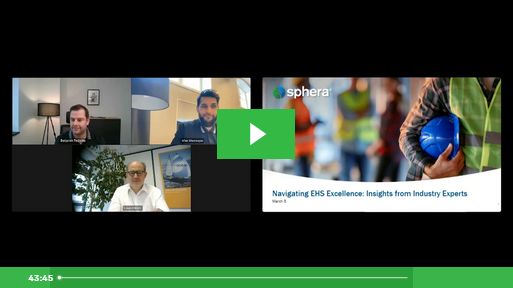Environment, health and safety (EHS) management is an integral part of every organization’s commitment to ensuring the well-being of its employees and the environment. In a recent Sphera webinar, two EHS leaders shared their experience with challenges related to EHS management and insights about future developments. We delve into these key areas in this blog to help other businesses navigate the evolving world of EHS.
EHS business challenges
Louis Engel, head of global EHS at specialty chemicals company Sika, and Benjamin Tschirley, EHS manager – digitalization, risk and incident management at pump and water solutions company Grundfos, shed light on the issues they have faced in their respective organizations.
- Leadership and commitment: Though vital to EHS success, leadership’s commitment to safety is sometimes lacking, according to Louis Engel.
- Acquisitions: Over time, Sika acquired companies with varying levels of maturity in safety, requiring constant adaptation at a corporate level to bring all divisions up to the required level.
- Operations focus: The companies’ EHS programs traditionally emphasized operations rather than sales and administration. The pandemic-related shift to remote work highlighted the need to also ensure the safety and well-being of employees in departments like sales and marketing.
- Lagging indicators: EHS performance is often measured by lagging indicators such as lost time incidents (LTI), leading to reactive EHS management and a negative internal perception toward safety. Both Grundfos and Sika wanted to direct EHS attention toward more proactive measures and a positive attitude and set up leading indicators.
The solution: changing internal EHS and safety culture
So, how were these matters addressed? Over several years, Sika implemented a comprehensive integration process to harmonize their safety standards across their newly acquired companies and embed safety practices in all aspects of the organization. The company’s specific actions included:
- Setting up an active global EHS network with regional EHS managers to support corporate initiatives.
- Adding safety performance to senior managers’ personal objectives.
- Creating a positive safety culture by celebrating success.
- Reporting observations and near misses rather than just accidents to help prevent accidents before they occur.
“EHS excellence is a marathon, not a sprint. Start with compliance and then move forward on your EHS journey. While leadership is essential to start and support the journey, the later stages of maturity are the most challenging. They require commitment from all employees to achieve true excellence.”
Louis Engel, head of global EHS, Sika
Similarly, Grundfos embarked on a mission to change the way safety was discussed within the organization. The company launched its Health, Safety and Wellness Ambition in May 2021 to expand EHS beyond the shop floor and create a unified approach to safety among different departments. The program emphasized three core behaviors for every employee: Be present, take action and don’t compromise.
The future of EHS: leading indicators and digitalization
Sika’s Louis Engel sees proactive monitoring via leading indicators, like safety work completion and safety audits, as the future of EHS. In particular, Sika has shifted its approach to audits. Instead of just checking compliance (“tick the box”), audits now focus on supporting workplaces and sharing best practices between sites.
Grundfos and Sika both see technology as an important part of future EHS initiatives. To solve its EHS challenges, Sika made incident reporting more transparent using SpheraCloud software to track incidents, near misses and observations and trace the completion of corrective actions. Similarly, Benjamin Tschirley of Grundfos sees digitalization as an enabler. Digital tools like Sphera’s cloud-based software, Power BI and even artificial intelligence (AI) can improve data analysis. While humans still make final decisions, AI’s processing power can be used to analyze large amounts of EHS data (e.g., thousands of incident reports) to identify patterns and trends.
“One powerful tool in our toolbox is digitalization. By leveraging digital solutions, we can streamline processes and become more efficient. Imagine spending less time on tedious paperwork and data entry, freeing you to focus on what truly matters.”
Benjamin Tschirley, EHS manager – digitalization, risk and incident management, Grundfos
Sphera Health and Safety Pulse Survey findings
The recent Sphera Health and Safety Pulse Survey uncovered critical insights into overcoming challenges that mirror the stories of Sika and Grundfos. Here are some key takeaways that resonated with these EHS leaders:
- Leadership plays a crucial role in building successful EHS programs. Training and updated objectives can help get managers on board.
- Limited resources are common and can be overcome with improved efficiency via technology adoption. Digital tools can facilitate safety reporting, training delivery, remote monitoring, communication and more.
- Breaking down siloes between different EHS functions—and even between EHS and ESG—fosters collaboration and holistic decision-making. ESG reporting can be a powerful tool for communicating the truth about company safety practices to stakeholders.
To gain a brief overview of how our software can support your company’s health and safety program, watch our 3-minute video.


